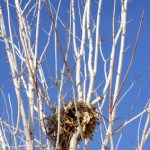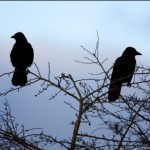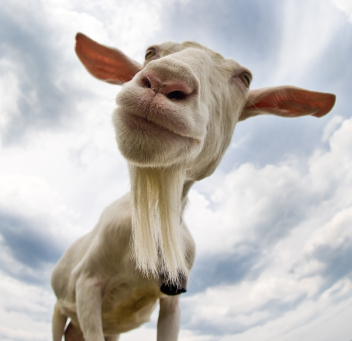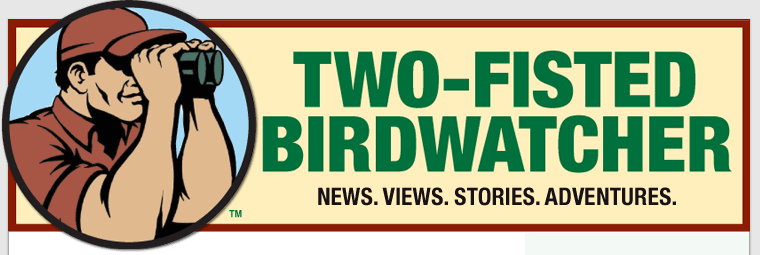It was late winter. Almost spring. The Curry Club was meeting. We do that on Sunday nights. We were hanging around a hangout called the Curry Nut. I’m not into curry, but the guy who owns the place makes a decent vodka martini. That and a basket of Nan bread is all I need.

“And you can hold the Nan”
Others in the club are adventuresome eaters. The dean’s a culinary show-off who just ordered curried goat.
The Curry Club is an informal think tank. We get together to kick around ideas and solve problems. Each person brings a different brand of savvy. We have a doctor, a rap promoter, a book critic, theater director, university dean and me, bird detective. On some nights the conversation turns to my odd calling.

“Big, round and high.”
The doctor told me he’d been wondering about oversized nests he noticed in trees on his property. His rap promoter neighbor chimed in saying that she’d been wondering about them, too. The nests were big, round, and high. I sipped my martini and smiled. This was too easy. But what do you expect from civilians who don’t know a cuckoo from a clock.
The doc said, “What kinda bird makes those? Gotta be big. We talkin’ crows?” I set down my drink, tore off a piece of Nan, and was about to answer when the dean butted in.
“Hey, speaking of crows, I’ve got a mystery,” he shouted. Doc’s question about big nests was left hanging. The dean went on, “I saw strange black birds in my trees and thought they were crows at first. But they were NOT…

Crows. Or were they?
The dean paused, waiting to make sure everyone was listening. I turned toward him, enjoying the chewy Nan. Nan and vodka. No need for curry. Or yogurt. Did I mention yogurt? It’s in the curries they make at Curry Nut.
“So, mister bird detective?”
“Big. Black. Sitting in your trees. Sounds like they were crows,” I said.
The dean steamed. I worried that bits of curried goat would start shooting out of his mouth. “You say I’m wrong?”
“Give me a little more to go on,” I say, chewing Nan.
“Look,” he says, “I know they’re not crows because they had crooked necks, and their bills were kind of crooked. Crows don’t look like that. Although these guys are big as crows, maybe bigger.”
This was a stumper. The guy lived in Chi-town’s ‘burbs near a river. Not a lot of suspects fit his description. Unless…
“I think I’ve got something,” I said.
But the doctor was getting impatient. He said, “Wait, what about my big nests? You were going to tell me what made them when our esteemed dean butted in? The theater director leaned into the conversation, her blonde hair bouncing as she said, “Maybe he butts because he keeps ordering goat when we come here!” The group laughed, but the doc still wanted to talk nests.

“Maybe he butts because he keeps ordering goat.”
“You’ll both get answers,” I said. “These are my kinda cases. One’s hard…” and I nodded to the dean. Then turning to the doc, I said, “…and one’s not. Now, doc, in the case of your big nests….”But I was interrupted, again, this time by the book reviewer. “And I’m sure the dean doesn’t even finish that curried goat. Don’t know why he takes it home. Bet he just tosses it out after a few days.”
“Can we forget about the damn goat,” cried the doctor. “Okay, I replied. “The nests were built by….” And before I could drop this bomb on him, the dean broke in again: “Don’t tell me they’re crows, they’re not.” I tossed back my martini. I have a pal who says one martini’s not enough, two are too many and three’s not enough. I like that. Not sure what it means, but that’s not my job. Bird detective is my job. I signaled our waiter to bring another.
I turned away from the doc and dealt with the domineering dean: “You’re right. They weren’t crows. They were Double-crested Cormorants. Big, black, curved necks and beaks. You live near water. Mystery solved.” Everyone looked at me. They were good at their things; I was good at mine. I faced my friend the doctor and said, “Now, as for your big nests….”
But, once again, before I could illuminate this group about the nest maker’s I.D. and M.O., the dean jumped in. Aha! Got you–they weren’t cormorants!

Cormorants! Or where they?“”
“And you know this, how?” I asked.
“I’m familiar with cormorants. At my condo in Florida I see them every day. I’m more familiar with cormorants than with crows! These were neither.”
Hmmm. I believed him. He was rarely wrong, which is how he got to be a dean. Where’d that second martini go? I don’t remember drinking it. Should I get a third? No. I’m working. I reached for the Nan. Was I stalling?
“Well, you can’t win ‘em all,” said the doctor, trying to regain the floor. “But I’ll bet you do know about my big nests. Lay it on me.”
I could do that. But it didn’t feel right. I didn’t want a consolation prize. I had unfinished business with the bossy dean. And I had the inkling of an idea. Something that was mentioned earlier nagged at my vodka-soaked brain. “Give me a moment,” I said to the group.
The book reviewer dug into her spicy seafood. The pretty theater director speared a piece of tofu. The doctor and the rap promoter were eating curried chicken. The smell of hot yogurt wafted. The dean pushed his goat around. And the answer to his mystery came to me in a flash.
“Friends, I can I.D. the big black birds for the dean, Then I’ll get to doc’s big nests. All before dessert.” I turned to the dean and said, “Not only will I tell you the kind of bird you saw, but I’ll tell you when. Last Wednesday, right?”
“How could you know that?” Then, softly, he said, “You’re right. Wednesday. I remember because….” And I finished his sentence. “It was garbage pickup day. You noticed them when you brought in the cans.” He looked at me and mumbled, “Right…”
“You brought last Sunday’s goat home in a doggie bag,” I said. “And after a few of days you threw it out. It was in your garbage, smelling as only goat can smell. Goat with yogurt. In your trees, attracted by this tangy garbage, there were… vultures.”

Case closed! Turkey Vultures.
Turkey Vultures with dark heads. They don’t all have red skin on their heads. Some immature ones have dark coloration. And looking at them against the sky, they’d appear all black. With crooked necks and beaks. Turkey Vultures. Attracted by old goat at the home of an old goat!”
The dean was quiet, for once. He was smart enough to know when he’d been bested, and he whispered “Wow.” He raised his iced tea in a toast. I raised my empty and we nodded at each other.
“All well and good,” said the doctor. “But as you were saying….my big nests are made by what kind of bird?”
“Oh yeah,” I said. “No bird.”
“No bird?”
“Yeah, no bird made those. They’re squirrel nests. They’re common. And they’re easy to see now, before leaves grow back and hide them. They’re called ‘dreys.’ Another word for squirrel nests. And for crossword puzzle nuts. “Squirrel,..” the doc said, looking pensively at his curried chicken. Imagine that.” Watching him and his unfinished dinner, I couldn’t help think: don’t they always say squirrel tastes just like…..naw, don’t go there. Maybe it was time for that third martini.
***


![image[2] image[2]](https://twofistedbirdwatcher.com/wp-content/uploads/2010/03/image2.jpg)

![image[1] image[1]](https://twofistedbirdwatcher.com/wp-content/uploads/2010/03/image1.jpg)






